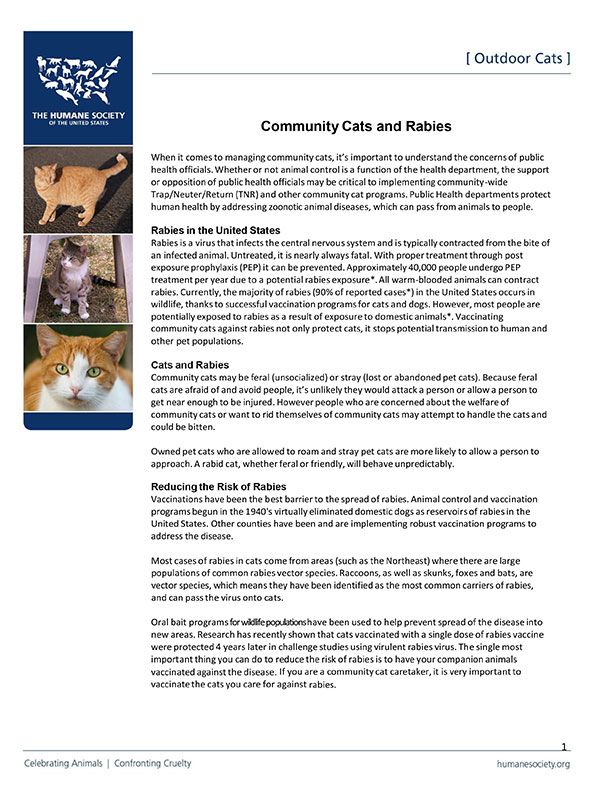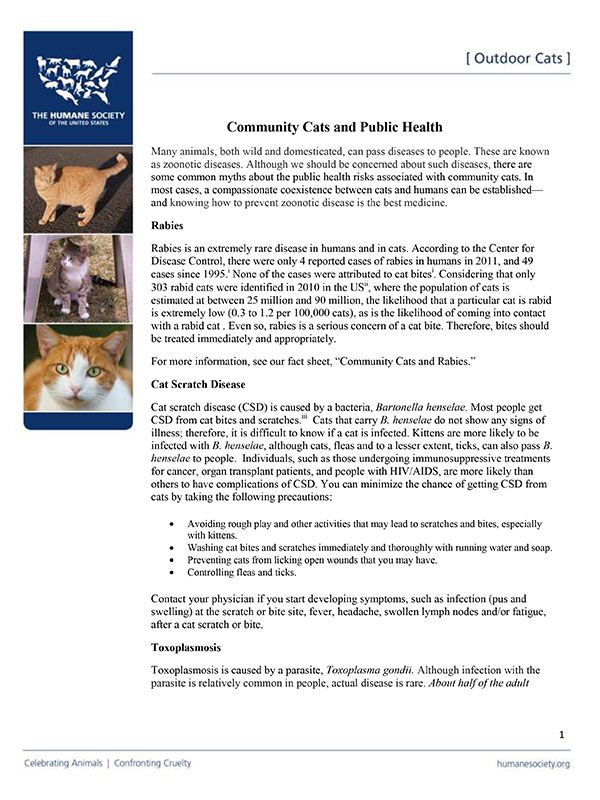Cats and public health
Get the facts about community cats and the risks to public health

Many animals, both wild and domesticated, can pass diseases to people. These are known as zoonotic diseases. Although we should be concerned about such diseases (like rabies, toxoplasmosis and more ), there are some common myths about the public health risks associated with community cats. In most cases, a compassionate coexistence between cats and humans can be established—and knowing how to prevent zoonotic disease is the best medicine.
“The Vet PH SPIG encourages communities to discuss trap, neuter, vaccinate and return (TNVR) as a management practice to control community cats, and to adopt this practice where possible.”
— American Public Health Association– Veterinary Public Health Special Interest Group Policy
Rabies
Rabies is an extremely rare disease in humans and in cats. According to the Center for Disease Control, there were only 4 reported cases of rabies in humans in 2011, and 49 cases since 1995. None of the cases were attributed to cat bites. Considering that only 303 rabid cats were identified in 2010 in the US, where the estimated population of outdoor cats ranges widely from 30 million to 90 million, the likelihood that a particular cat is rabid is extremely low (approximately 0.3 to 1.2 per 100,000 cats), as is the likelihood of coming into contact with a rabid cat. The last documented case of human rabies from exposure to a rabid cat was in 1975.
However, even when the risk is so small, the seriousness of rabies makes it paramount that vaccination programs are a high priority in communities and that any cat bites are taken seriously and treated immediately and appropriately.
“Collectively, our goal is to eliminate the free-roaming cat population and decrease the spread of rabies in our communities. The only approach that has proven effective is conducting large-scale, targeted sterilization and vaccination programs that result in healthier cats and healthier communities.” — Dr. Karyl Rattay, Delaware Division of Public Health Director, Wilmington, DE
Download our Community Cats and Rabies information sheet.
Toxoplasmosis
Toxoplasmosis is caused by a single-celled parasite, Toxoplasma gondii. Although infection with the parasite is relatively common in people, actual clinical disease is rare. When illness does occur, it is usually mild with "flu-like" symptoms that last for weeks to months and then go away. However, the parasite remains in their body in an inactive state. It can become reactivated if the person becomes immunosuppressed. In the United States, it is estimated that 22.5% of the population 12 years and older have been infected with Toxoplasma, developed protective antibodies, and are probably immune to Toxoplasma reinfection.
However, infection could cause serious health problems for the infant of a pregnant woman who has never been exposed and developed immunity, as well as immune-compromised individuals. Nonetheless, it’s not necessary to get rid of pet cats to avoid this parasite. A person is more likely to be infected with T. gondii from eating raw or undercooked meat or gardening in contaminated soil. The U.S. Centers for Disease Control and Prevention lists toxoplasmosis as a food-borne illness and does not recommend relinquishment of pet cats as a preventative measure.
Cats, and other feline species, are the definitive host for the parasite. However, it is important to understand that once a cat has been infected with toxoplasmosis they shed the parasite in their feces for only 1-2 weeks. As a result, they develop immunity and can rarely be re-infected or pass potentially infectious feces again. Toxoplasma oocysts shed in cat feces take 1-5 days to sporulate in the environment and become infective. Cats, and other animals, including people, get toxoplasmosis by accidentally ingesting cat feces that contain infective Toxoplasma oocysts or by eating animals already infected with toxoplasmosis.
“Cats have gotten a bad rap about how they transmit toxoplasmosis to humans. While it is true that cats are the definitive host for the infective stage of the Toxoplasma organism, they are not the most common source of infection, which according to experts is eating undercooked, contaminated meat.” — Dr. G. Robert Wheedon, DVM, MPH, College of Veterinary Medicine at the University of Illinois at Champaign-Urbana
Download our Community Cats and Public Health information sheet.
Other Diseases
You may hear about intestinal parasites such as roundworm, fungal diseases like ringworm, or two bacterial diseases, Cat Scratch Fever and plague. The good news is that common-sense precautions are usually enough to prevent infection. Things like good sanitation, treating flea infestations quickly and effectively, washing hands after gardening or playing outside in the soil, and addressing any health concerns with your pets at your veterinarian’s office will help prevent any zoonotic disease from finding a new body to inhabit. Check out our downloadable Community Cats and Public Health information sheet for more info on these diseases.
Learn more about disease control, related research and protecting cats.
Documents





